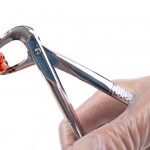
It is estimated that in 2020 there were 900,000 new cases of head and neck cancer (HNC) worldwide with around 460,000 deaths. Early-stage cancers may be treated with surgery or radiotherapy while locally advances cancers which account for around 60% of those with HNC receive approaches that include surgery and radiotherapy with or without chemotherapy. Radiotherapy (RT) has a key role but has a range or acute and late toxicities including oral mucositis, xerostomia, dysphagia, and osteoradionecrosis. Risk factors for osteoradionecrosis (ORN) include alcohol and tobacco abuse, patient comorbidities (e.g., diabetes), poor oral hygiene, tumour size and location, staging, radiation dose and fractionation, and dental extractions
The aim of this review was to determine whether tooth extraction prior to head and neck RT is associated with a reduced risk of developing ORN compared to dental extraction after or during RT.
Methods
Searches were conducted in the Cochrane Library, Embase, LILACS, PubMed, Scopus, and Web of Science, Google Scholar, OpenGrey, and ProQuest databases. Observational studies (cross-sectional, cohort or case–control) and clinical trials of tooth extractions in patients receiving head and neck RT were considered. Two reviewers independently screened and selected studies wit h data being extracted by a single reviewer and cross-checked by a second reviewer with discrepancies being resolved by discussion. Risk of bias of individual studies was independently assessed by two reviewers using the Joanna Briggs Institute (JBI) Critical Appraisal Tools for Analytical Cross-sectional studies and the certainty of evidence was assessed using the GRADE approach.
Results
- 28 studies (24 retrospective cross-sectional,3 retrospective cohorts, 1 single-arm prospective) involving a total of 50,192 patients were included.
- A majority of the included patients were male (44,062; 87.8%) with ages ranging from 7 to 94 years.
- 17 studies reported on deleterious habits (tobacco & alcohol use) and 10 studies on comorbidities.
- Most patients were diagnosed with tumours of stages III–IV
- In total 33,662 patients had pre-RT tooth extractions and 11,705 post- RT extractions with only, only 1265 having extractions during RT.
- The pre-RT period ranged from 3 to 210 days (mean 24.7 days), while the post-RT extraction interval ranged from 3 months to 13.4 years.
- The overall prevalence of ORN in the studies ranged from 2.14% to 22.1% [data from 19 studies].
- 8 studies were considered to have a high risk of bias, 16 a low risk and 4 a moderate risk.
- Meta-analysis (17 studies) showed a significant association of post-RT dental extractions with the risk of ORN development, Odds ratio (OR) = 1.98 (95%CI: 1.17 to 3.35).
- For studies that only included HNC patients who were diagnosed with ORN meta-analysis (11 studies) demonstrated no association between ORN risk and tooth extraction before or after RT, OR= 1.70 (95%CI: 0.94 to 3.07) However, if the studies at high-risk were removed an association was noted, OR= 2.02 (95%CI: 1.02 to 3.98).
Conclusions
The authors concluded: –
… extracting compromised teeth prior to head and neck radiotherapy is associated with a lower risk of developing ORN compared to performing dental extractions after or during RT, with a moderate certainty of evidence.
Comments
A protocol for the review was registered in the PROSPERO databases and a broad range of databases were searched. The main aim of this review was to determine the best time to perform dental extractions in patients who are being treated with head and neck RT to reduce the risk of developing ORN. The findings indicate that compromised teeth should be extracted before head and neck RT. However the finding should be interpreted carefully as all but one of the studies was retrospective and while most studies identified potential confounders they did not report how these were managed and only 16 (57%) of the included studies was a low risk of bias. The data presentation in the individual studies was also heterogenous in relation to treatment modalities, radiation dosages and statistical analysis. While the certainty of the evidence was assessed as moderate this means that further research may have an important impact on the confidence in the estimate of the effect and may change it. Additional well conducted and reported prospective studies are needed to improve the certainty of evidence in relation to timing of RT and the risk of ORN.
Links
Primary Paper
Normando AGC, Pérez-de-Oliveira ME, Guerra ENS, Lopes MA, Rocha AC, Brandão TB, Prado-Ribeiro AC, Gueiros LAM, Epstein JB, Migliorati CA, Santos-Silva AR; Oral Care Study Group, Multinational Association of Supportive Care in Cancer (MASCC)/International Society of Oral Oncology (ISOO). To extract or not extract teeth prior to head and neck radiotherapy? A systematic review and meta-analysis. Support Care Cancer. 2022 Jun 17. doi: 10.1007/s00520-022-07215-y. Epub ahead of print. PMID: 35713725.
Other references
Dental Elf – 6th Oct 2021
Dental Elf – 21st Apr 2021
Osteoradionecrosis incidence and the timing of dental extractions
Dental Elf – 1st Mar 2013
